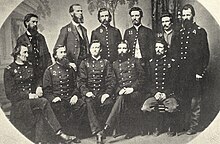4th Michigan Cavalry Regiment was a regiment of cavalry in the Union Army during the American Civil War fighting in the western front as part of the Army of the Cumberland. It was noted as being the regiment that captured the fleeing President of the Confederate States of America, Jefferson Davis, as the Confederacy collapsed in the spring of 1865.
The 8th Kansas Infantry Regiment was an infantry regiment that served in the Union Army during the American Civil War.
The 13th Ohio Infantry Regiment was an infantry regiment in the Union Army during the American Civil War.
The 26th Ohio Infantry Regiment was an infantry regiment in the Union Army during the American Civil War. It was often referred to by its members as the Groundhog Regiment.
The 40th Regiment Indiana Infantry was an infantry regiment that served in the Union Army during the American Civil War.
The 81st Regiment Indiana Infantry was an infantry regiment that served in the Union Army during the American Civil War.
The 15th Ohio Infantry Regiment was an infantry regiment in the Union Army during the American Civil War.
Battery E, 1st Ohio Light Artillery was an artillery battery that served in the Union Army during the American Civil War.
The 2nd Tennessee Infantry Regiment was an infantry regiment that served in the Union Army during the American Civil War.
The 6th Regiment Tennessee Volunteer Infantry was an infantry regiment that served in the Union Army during the American Civil War.

The 5th Tennessee Cavalry Regiment was a cavalry regiment that served in the Union Army during the American Civil War. This regiment was originally recruited as the 1st Middle Tennessee Cavalry.
Battery A, 1st Battalion Tennessee Light Artillery was an artillery battery that served in the Union Army during the American Civil War. It was also known as Company A, 1st Middle Tennessee Battery.
The 9th Tennessee Cavalry Regiment was a cavalry regiment that served in the Union Army during the American Civil War.
The 4th Tennessee Cavalry Regiment was a cavalry regiment that served in the Union Army during the American Civil War. It was originally recruited as the 4th East Tennessee Cavalry.
The 106th Ohio Infantry Regiment, sometimes 106th Ohio Volunteer Infantry was an infantry regiment in the Union Army during the American Civil War. It was also known as the 4th German Regiment.
The 108th Ohio Infantry Regiment, sometimes 108th Ohio Volunteer Infantry was an infantry regiment in the Union Army during the American Civil War.
The 113th Ohio Infantry Regiment, sometimes 113th Ohio Volunteer Infantry was an infantry regiment in the Union Army during the American Civil War.
The 115th Ohio Infantry Regiment, sometimes 115th Ohio Volunteer Infantry was an infantry regiment in the Union Army during the American Civil War.
The 12th Ohio Cavalry Regiment was a cavalry regiment that served in the Union Army during the American Civil War.

James Patton Brownlow was a Union Army officer during the American Civil War. Brownlow was the son of East Tennessee preacher and politician Parson Brownlow. James P. Brownlow served in several positions in the Union Army, finishing the war as colonel of the 1st Tennessee Cavalry Regiment. He was noted for his courage and perceptiveness in battle and keen sense of military tactics. Union cavalry in Tennessee, in addition to participating in crucial organized battles of the war, "primarily meant almost endless skirmishing with partisans, guerrillas, and bushwackers, as well as with the Rebel raiders of John Hunt Morgan, Joseph Wheeler, and Nathan Bedford Forrest, who frequently recruited and supplied themselves from behind enemy lines." Jim Brownlow's deft handling of these engagements left him with a reputation as "one of the greatest daredevils of the Civil War."



